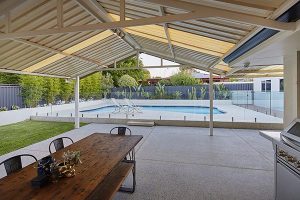WHAT TO DO WHEN YOU NEED TO INSTALL A HARD WIRED RETIC CONTROLLER
When installing, servicing and repairing reticulation controllers in Perth there are a number of things to be mindful of. Firstly, there are different types of controller set-ups. There are hard-wired controllers, in which the controller is directly connected to the electricity. In the picture below you will see a hard wired retic controller.
The two red wires on the left are going directly into the transformer and there is no power plug. The transformer turns the power from 240 Volts, which is lethal, to 24 Volts, which will operate a solenoid valve correctly. To be clear, we never open up the transformer box of a hard wired controller. This is illegal and very dangerous. If the controller is hardwired, we call our electrician to come and change it for us.
The two screws where the two red wires on the left hand side go into are the 24 Volt AC Ports which give the controller its 24 Volt power. These wires are not dangerous. The common wire port and solenoids wire ports screws are also not dangerous and we are allowed to wire up all low voltage retic wiring. If the controller is a plug in type and there is an available power point, then we can change it as long as we do not open that transformer box. To be clear, if the transformer needs replacing in one of these controllers, then again with the internal type of transformer we need to get our electrician to do this. Never replace the internal type of transformer and never replace a hardwired controller.
EXTERNAL TRANSFORMERS AND INDOOR CONTROLLERS
You will see another type of controller with an external Transformer. With these controllers, the two black wires from the external will run into the controller and into the two 24 volt ports inside the controller. These controllers are safe to install and replace, provided that there is a power point already installed by a licenced electrician. Again, do not open up the transformer. Never try to open up and fix a transformer. If the transformer stops working on these external models (BLACK EXTERNAL TRANSFORMER ONLY), then we just buy a new one and replace it. Most indoor controllers have an external transformer.
IS IT HARD WIRED OR NOT?
Below you will see a new example. If you look closely, the two black wires on the top right are going into the 24 volt AC ports in the controller. They are going into the wall cavity as you can see. It is very common, particularly with older jobs, to have a transformer in the roof cavity or plugged in inside with the wires running through the wall and back up into the controller. This type of controller is safe to change as the wires are already transformed down and are coming from an external transformer inside the house or roof or next to the controller on the wall. To see if the transformer has power, touch the two low voltage 24 volt wires coming from the transformer together (the ones you have taken out of the 24 Volt AC Ports). If they spark, you have power. If they do not spark, you need to locate the transformer and change it. Remember, you only change the plug in transformers that are outside of the controller and never change a transformer inside a controller. Never open a transformer to fix it, leave that to the electricians. Remember, never touch any wires going into any transformer and never touch any live power. We only deal with the low voltage wiring.
LOOP THE BORE WIRES
When servicing or installing any reticulation systems that have a bore, it is very important to make sure the bore wires are looped. See from the example below that there is only one wire going to a solenoid in station one. However, we have looped the wires from station 4 all the way back to station 1, meaning if station 4 is turned on, then station 1 will come on. If 3 is turned on, 1 will come on and so on. What we have done is looped any terminals not being used back to the nearest or last station to be wired in. What this does is protect the bore form running against a closed head. If we did not loop the wires and someone came and turned station 2 on by mistake, the bore would turn on but no solenoid would open up. The bore would be pumping and pumping but would be unable to release any water as it would stay contained in the main supply line. On any job where we service the retic, install the retic, are called to set the controller or anything else, we are responsible to check this and if the wires are not looped, then we need to loop them.
Setting Controllers
Once you have repaired or installed your retic controller you will need to set it according to the water corporations guidelines – www.watercorporation.com.au/save-water/watering-days
SUMMARY
- Never install, replace, or repair a hard wired controller.
- Never replace an internal transformer inside a controller.
- Some portable transformers are in the roof or inside and the wires run through the wall and out of the wall cavity. We can replace these controllers and wire them back into the 24 Volt AC as the wires are already after the transformer and wired down.
- Always loop bore wires on every single job.
- Always call an expert if in doubt-always use a licensed electrician for anything to do with live power.
- Never open up a transformer and repair it.
- You can replace an outside portable plug in transformer, but you cannot repair it.
- Never touch any live power and never do any wiring before the transformer.
- Check every setting, start time and program on every controller we come in contact with. Also check the watering days
Need help repairing your reticulation?
Luke’s Landscaping, we’ve seen it all. Whatever your problem, be it retic repair in Perth, installing a new irrigation system or something else, we have the experience and know-how to tackle your project. Contact us to day to ask for some friendly advice or book in a service.
Need Us To Help With Your Garden?


